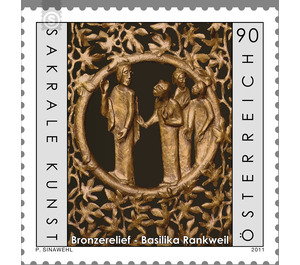Sacred art - Austria / II. Republic of Austria 2011 - 90 Euro Cent
Theme: Architecture
| Country | Austria / II. Republic of Austria |
| Issue Date | 2011 |
| Face Value | 90.00 |
| Edition Issued | 250,000 |
| Printing Type | combination printing |
| Stamp Type | Commemorative |
| Item Type | Stamp |
| Chronological Issue Number | 2284 |
| Chronological Chapter | OOS-OE2 |
| SID | 427160 |
| In 55 Wishlists | |
With the new value "Bronze relief - Basilica Rankweil" the popular series "Sacred art in Austria" now finds its attractive continuation. The stamp motif shows a part of this little gem created by Ulrich Henn, a German sculptor. To the basilica: A special form of early Christian cult buildings in Rätien are the so-called church castles. They were laid out at hard-to-reach heights, surrounded by a wall ring and usually also by a cemetery. The church on the 50 meter high Liebfrauenberg in Rankweil is such a fortified church. It formed the center of a large parish from the 8th century, which at times covered large parts of Vorarlberg's front country and reached into the Swiss Rhine Valley. Completely burned down in the 14th century by military events, the church of St. Mary was built in Gothic style from 1470 to 1510 in the same place. In 1657, builder Michael Beer created a Loreto chapel with the mercy altar. It is interesting that the Liebfrauenkirche maintained its significant religious charisma through all the centuries, supported, of course, by the pilgrimage destinations and the central location in the center of Vorarlberg. Today, the basilica parish church of the parish "to Our Lady of the Visitation" in Rankweil. The famous church houses several sacral treasures, including, for example, the Byzantine-Romanesque cross of images "Silver Cross" (probably a gift from Charlemagne to Count Hunfried) and the Romanesque crossbow cross, the so-called "Kümmerniskreuz". The relief on the mark "healing a woman" is meanwhile a work of art from our time - it is part of a 1986 created bronze altar and comes, as mentioned above, from Ulrich Henn. Born in Schwäbisch Hall in 1925, the artist created his first works of art in American captivity, using razor blades and ammunition boxwood. In 1948 Henn founded his own studio in Stuttgart and became a self-employed sculptor. Since then, countless important sacred works of art have been produced in many different countries, including church portals, fountains, freestanding sculptures, altars, and subtly worked tabernacles, which show Henn's fine "handwriting" in an unmistakably beautiful manner.


